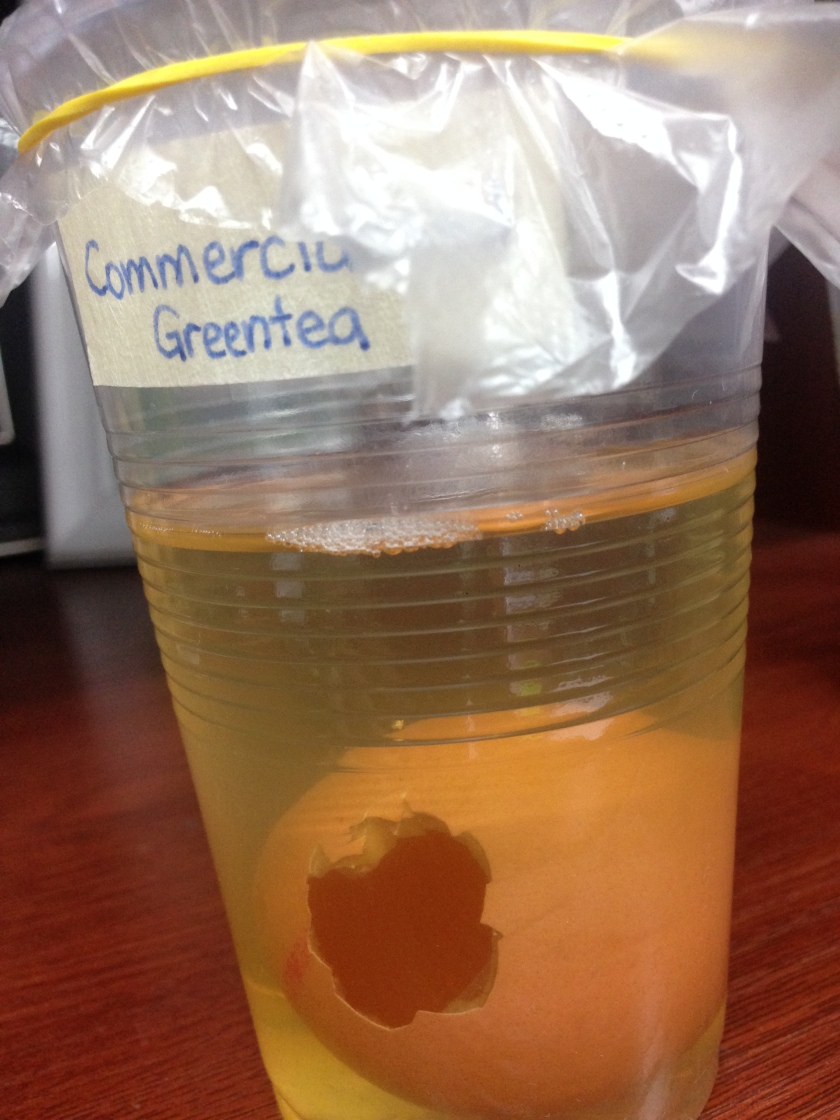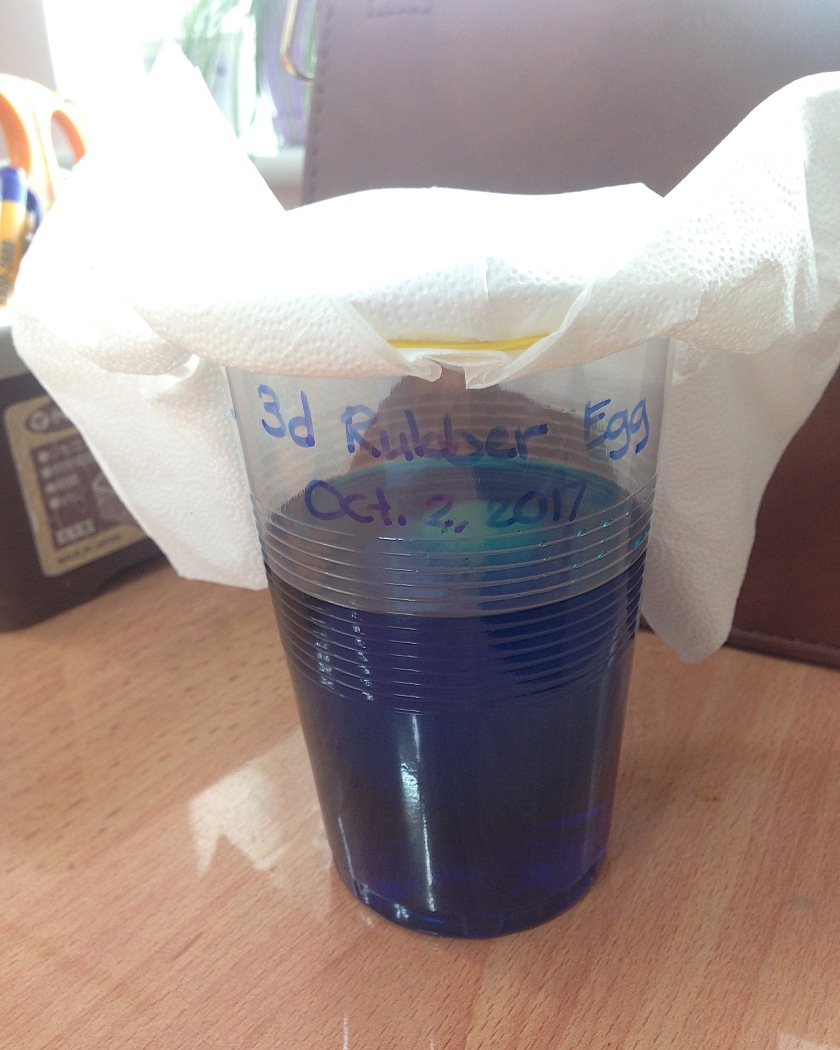Author: mrsmommai
Making Rubber Eggs
THAT MAKES SENSE: Exploring the five senses
(We used boiled eggs instead of raw eggs)
[Grade 3] THAT MAKES SENSE: Exploring the FIVE SENSES
• Exploring the FIVE SENSES •
What’s in the box?
**Students were blindfolded and were asked to pick up an item from the box. They have to touch/ feel and describe the object they have picked and they have to guess what it is.
Loud Sound or Soft Sound?
**Students had to guess which of the items make the loud sound, the soft sound.


[Grade 4] Week 5: What does too much SUGAR do to our TEETH?
•••Observation: What does too much SUGAR do to our TEETH?•••
Which drinks have the most sugar?
Aloe Vera drink –
Lemon water –
green tea –
orange juice –
soda zero –
soda original –
• Trial #1: September 27, 2017 4:45pm
5 boiled eggs
purified water
commercialized green tea
soda zero
soda original
orange juice
• Trial #2: September 28, 2017 11:29am
raw egg shells
aloe drink
lemon water
purified water
commercialized green tea
soda zero
soda original
orange juice
**5 Days Later**
October 3, 2017, Trial #2 Results *with raw eggshells*
*The samples were taken out because they started to grow moulds already*
COKE and COKE ZERO
Commercialized Green tea

Lemon Water
Orange Juice
Aloe vera Drink
Tried also with other sugary drinks:
[Grade 4] Week4: Food Groups
• Looking after ourselves •
• To identify/ classify different food groups:
Healthy (Everyday) Vs. Not Healthy (Sometimes)
Go, Grow, Glow Food
Carbohydrates, Proteins, Fats, Vitamins, Minerals
• Springboard •
Identify the following whether they are “everyday” food or “sometimes” food:
lettuce cheese pizza nuts rice sausages candy apples ham cake
carrots meat pasta milk orange chocolate chicken banana popcorn watermelon
| Go Foods | Grow Foods | Glow Foods |
| > provide you with heat and energy | > help you grow TALL and STRONG | > keeps your body well |
| > rich in carbohydrates, fats | > are rich in protein | > rich in vitamins and minerals |
| starches and sugars | > keep the blood red | > help you maintain good eyesight |
| > make bones, nails and | and healthy skin | |
| Examples: | teeth hard and strong | > keep us from illness/ sickness |
| Rice, bread, pasta, cheese, butter | Examples: | Examples: |
| corn flakes, potato, corn | Chicken, Tuna, eggs, meat, beans | apples, bananas, carrots, lettuce, |
| nuts, tofu, milk and cheese | tomatoes, pineapple, spinach | |
**Carbohydrates give you energy (sugary and starchy foods like: potatoes, rice, cereals, pasta, bread)
**Fats act as the body’s reserve tank of energy, helps our bodies stay warm in cold weather, (dairy products, red meat, poultry, fish and many of the ‘sometimes’ foods)
**Protein helps your body grow and repair itself (meat, poultry, fish, dairy products, eggs and beans
**Minerals help your body grow, develop and be healthy
Iron is good for the blood, Calcium is good for the bones and teeth, Magnesium is good for the nerves (fruits and vegetables)
**Vitamins: vitamin means vital/ essential to life
Vitamin A: Orange and yellow fruits and vegetables (like carrots, sweet potato and pumpkin) and green leafy vegetables, milk and cheese, egg yolk, liver, fish oils
Vitamin D: Tuna, sardines and salmon, Margarines (vitamins added), Milk, butter and cheese, Eggs
Vitamin E: Vegetable oils and some margarine, Nuts and seeds.
Vitamin K: Leafy green vegetables like spinach, broccoli and cabbage, liver.
A
I help you see at night and help your body fight infections
D
I help make strong bones
E
I protect your skin
K
I help stop bleeding
Observation: What does too much SUGAR do to our TEETH?
Resources:
Cambridge Primary Science 3
http://www.cyh.com/HealthTopics/HealthTopicSearchResults.aspx?p=269&search=food&weekly=False
[Grade 5] Week Four: Observation
Objective: To determine which added material will make ice melt the fastest.
This week is observation week, and we will start with “melting”
Review:
∗Solids are often hard and brittle.
∗Liquids are fluid, can move around a little and fill up containers.
∗Gases are always around you.
Today….
We will determine which added material will make the ice cubes melt the fastest.
The changes of state of matter
•When a substance changes from one state or phase to another. (Changes always occur with the change of HEAT.
Today’s Observation:
What makes ICE melt the fastest?
Will a cube of ice melt faster in hot water or in cold water?
Will a cube of ice melt faster in sugar or in salt?
Materials:
ice cubes
transparent cups, bowls
sugar (15ml) + hot water (15ml)
salt (15ml) + hot water (15ml)
hot water (60 ml)
cold water (60 ml)
stopwatch or phone timer
cup labels
[CLASS 5b September 25, 2017]
Time 11:05-11:45, Room 102
Trial #1 Result:
Ice melting in minutes
a. 60 ml Hot water – 2.48 minutes
b. 60 ml Cold water – estimated 22 minutes* (due to time constraint / limited time)
c. sugar (15ml) + hot water (15ml) – estimated 15 minutes* (due to time constraint / limited time)
d. salt (15ml) + hot water (15ml) – 12 minutes
[CLASS 5c September 25, 2017]
Time 11:50-12:30, Room 103
Trial #2 Result:
Ice melting in minutes
a. 60 ml Hot water – 2.25 minutes
b. 60 ml Cold water – estimated 23 minutes* (due to time limit)
c. sugar (15ml) + hot water (15ml) – estimated 16 minutes* (due to time limit
d. salt (15ml) + hot water (15ml) – 13 minutes
[CLASS 5g September 26, 2017]
Time 14:15-14:55, Room 207
Trial #3
Result:
Ice melting in minutes
a. 60 ml Hot water – 2.23 mins
b. 60 ml Cold water – 52.33 mins
c. sugar (15ml) + hot water (15ml) – 37.35 mins
d. salt (15ml) + hot water (15ml) – 24 mins
[CLASS 5a September 27, 2017]
Time 12:35-13:15, Room 108
Trial #4 Result:
Ice melting in minutes
a. 60 ml Hot water – 1.59 mins
b. 60 ml Cold water – 45 mins
c. sugar (15ml) + hot water (15ml) – 33 mins
d. salt (15ml) + hot water (15ml) – 21.41 mins
••Homework••
Trial #5 Result:
Ice melting in minutes
sugar (15ml) + hot water (15ml) –
salt (15ml) + hot water (15ml) –
sugar (15ml) + cold water (15ml) –
salt (15ml) + cold water (15ml) –
SAMPLE Graphical presentation of data

[To be updated]
Sources:
Cambridge Primary Science 4
https://en.wikiversity.org/wiki/Primary_Science_Experiments/Melting_ice_cube_experiment
FREE Downloadables on TPT
Check out my store on https://www.teacherspayteachers.com/Store/Littletootsies-Archive for free resources.
• The Vinegar and Baking Soda Observation •
• Understanding and Exploring the Scientific Method •
Blowing up a balloon with vinegar + baking soda [vinegar: 20% vs 6%]
https://www.instagram.com/p/BY8P-Y0ls2M9dKp_mem2s37O15_6drv5y93vwk0/
Image source: https://www.pinterest.com/pin/324540716883366018/
Grades 4-5: September 11-15
Orientation to the Curriculum
⇐ Review ⇒
What is Science?
Science is the study of the world around us.
What is a SCIENTIFIC METHOD?
The Scientific method is an organized (step by step) way to answer questions and solve problems.
*The 7 Scientific method steps ASITCIS
Ask questions
State hypothesis
Identify variables
Test hypothesis
Collect data
Interpret data
State conclusion
Key Vocabulary
discovers measures records observes invents explores experiments classifies collects research guess/ hypothesis conclusion gathering accurate reliable organize interpret identify
In Science…
– We ask questions.
– We read to gather information.
– We collect evidence or data.
– We make a guess (hypothesis)
– We experiment.
– We observe.
– We interpret.
– We make a conclusion.
Class Homework:
Bring a box of baking soda
A Bottle of Vinegar
Food Colors & Balloons
Paper towels
Sources:
[google images]
Click to access Notes%20and%20things%20to%20study.pdf
https://sciencebob.com/science-fair-ideas/the-scientific-method/




































































![SONY DSC [Left: Ice melting in 60 ml cold water; Right: Ice melting in 60 ml hot water]](https://littlemattersmatter.files.wordpress.com/2017/09/dsc00152.jpg?w=416&resize=416%2C277&h=277#038;h=277)
![SONY DSC [Left: Ice melting in 60 ml cold water; Right: Ice melting in 60 ml hot water]](https://littlemattersmatter.files.wordpress.com/2017/09/dsc00154.jpg?w=416&resize=416%2C277&h=277#038;h=277)









